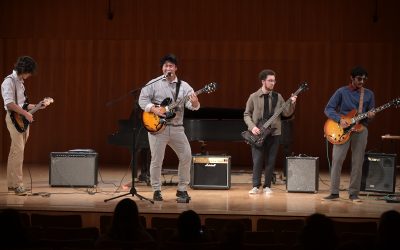Within the context of a liberal arts education, the Drew University Music Department nurtures and supports the development of a well-rounded and integrated understanding of music through a balanced curriculum providing experiences in historical study and research, solo and ensemble performance, theoretical and style analysis, and original composition work. The foundation of our curriculum is built upon the classical Western European tradition with extensions provided into musics of the world, jazz, popular, and new music practices.
The study of music at Drew extends a student’s comprehension of history and society while also preparing him or her for a career in music. The expression of ideas and emotions through music is integral to every culture. The broadly educated musician is in demand in the recording industry, education, theater, film, television, and radio.
Faculty work closely with students to create a curriculum integrating the study of Music History, Composition/Theory & Performance.
Guidelines for Majors/Minors
Below are suggested guidelines of the order in which to take the required courses for the music major/minor. The goal is that students aim to take all the introductory, 100-level courses in their first year, the intermediate 200-level courses in their second year, and the advanced 300-level courses in their third and fourth years. In other words, it makes the most sense to take introductory courses in all areas of music composition, music theory, music history and performance before taking intermediate courses in any of these areas.Keep in mind, however, that these are only suggested guidelines. Individual students may have good reason to take certain courses out of order, based on factors such as:
(1) prior experience (or lack of experience) in certain areas;
(2) the year/semester in which they initially decide to pursue the music major;
(3) scheduling needs to accommodate double majors, minors, and/or study abroad;
(4) frequency of certain course offerings.
Students should consult with their advisors as to how to implement/adapt these guidelines to meet their individual situations. Contact your advisor, or the chair of the Music Department, with any questions or concerns.
IN THE FIRST YEAR:
- Music 102 (if not waived)
- Music 103
- Music 252 (if not waived)
- For music majors who wish to place out of MUS 252, please arrange with Professor Iskowitz to perform:
– Two pieces of comparable difficulty to Minuet in G Major by J. S. Bach. Pieces by popular artists are acceptable. Memorization is not required. You may contact Prof. Iskowitz for suggestions regarding repertoire.
– Two Scales, one major and one minor, hands together, one octave (other than C major/a minor).
– Sight-read a piece of up to eight measures in length, with hands playing together outside of a five-finger position.
- For music majors who wish to place out of MUS 252, please arrange with Professor Iskowitz to perform:
- Private instruction at the 100 level
- Ensembles
IN THE SECOND YEAR:
- Music 227/227L
- Music 228/228L
- Music 231-240 “Music and Culture”
- Music 260
- Music 223 (prerequisites: 102, 103)
- Private instruction at the 100 and/or 300 level
- Ensembles
IN THE THIRD AND FOURTH YEARS:
- Music 246 (prerequisite: 227)
- Music 337
- Music 324 (prerequisite: 228 or 260)
- Music 301, 303, 311, 341 (prerequisite: 103)
- Private instruction at the 300 level
- Ensembles

The Famous Moog Synthesizer
The Moog synthesizer pictured on the cover of the recording of Wendy Carlos’ Switched-On Bach belonged to Columbia Records. Sometime around 1978 Lydia Ledeen, then chair of the Music Department, got a call from a friend who worked for Columbia Records asking if we might be interested in acquiring these modules. They had been replaced by newer equipment. Lydia asked Norman Lowrey, at that time our resident composer, and he jumped at the chance.
Already by 1978 this equipment was becoming obsolete. Its manufacturing date was 1968. Only 10 years old. But what a wonderful teaching tool. We’ve now expanded into the digital realm, but the Moog still serves as the starting point for our Electronic Music Composition course. It’s still capable of producing groovy analog sounds like no other synthesizer!





